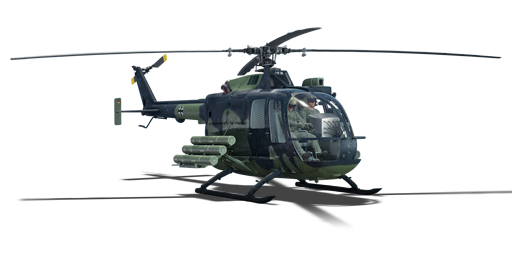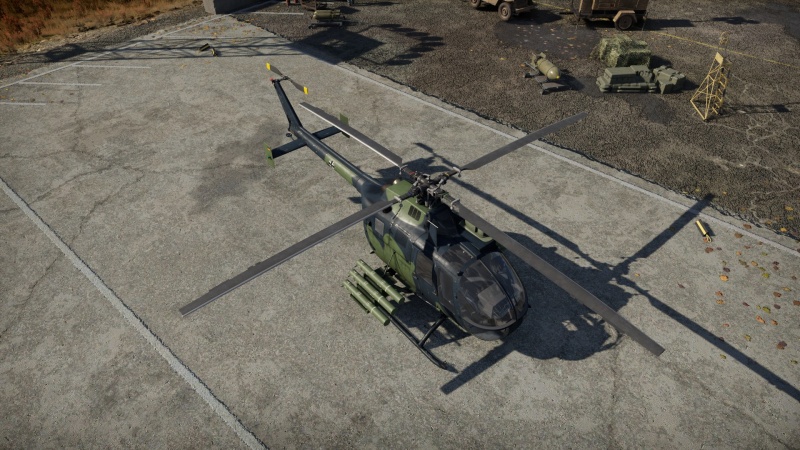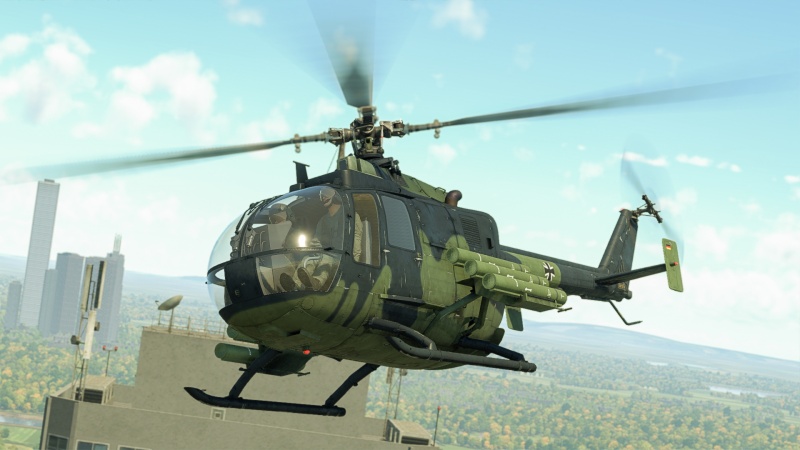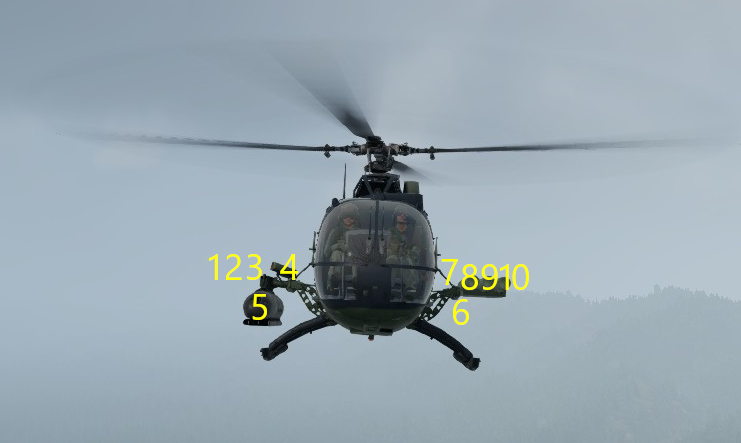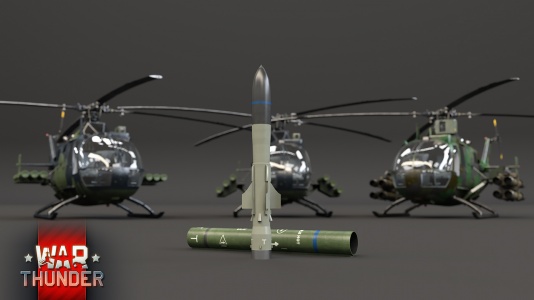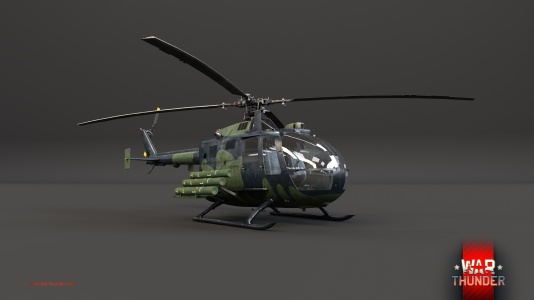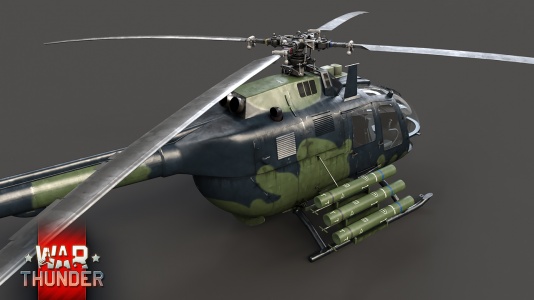Difference between revisions of "BO 105 PAH-1A1"
(→Description: Updated to new standard) |
(added the video to the media section) |
||
| Line 179: | Line 179: | ||
File:BO 105 PAH-1A1 WTWallpaper 002.jpg | File:BO 105 PAH-1A1 WTWallpaper 002.jpg | ||
</gallery> | </gallery> | ||
| + | |||
| + | ;Videos | ||
| + | {{Youtube-gallery|1IhZl0Q5meY|'''Ultimate BO-105 Guide''' -By Bob Dickinson.}} | ||
== See also == | == See also == | ||
Revision as of 14:39, 10 November 2024
| This page is about the German utility helicopter BO 105 PAH-1A1. For other versions, see BO 105 (Family). |
Contents
Description
The BO 105 PAH-1A1 was a modification of the German BO 105 PAH-1. This version saw the installation of HOT-2 anti-tank guided missiles, upgrades to the electronics and targeting systems, and new rotor blades. Some existing PAH-1s were upgraded to the new standard from 1991; however, due to the helicopter's inability to perform combat missions at night and its low survivability, from 2007 it began to be replaced in the Bundeswehr by the more modern Eurocopter Tiger. The last BO 105 helicopters were withdrawn from service with the German army in 2016.
The BO 105 PAH-1A1 was introduced in Update 1.83 "Masters of the Sea". Its main difference from the BO 105 PAH-1 is the replacement of HOT anti-tank guided missiles with HOT-2 missiles boasting increased penetration. Otherwise, it remains the same light, fast, agile, and compact helicopter capable of delivering swift and decisive attacks, as well as quickly evading ground fire, although its light construction means it lacks any armour protection.
General info
Flight performance
| Characteristics | Max Speed (km/h at 0 m - at sea level) |
Max altitude (metres) | |
|---|---|---|---|
| AB | RB | ||
| Stock | 218 | 200 | 5180 |
| Upgraded | 251 | 242 | |
The BO 105 PAH-1A1 is without a doubt a very agile helicopter, being able to perform barrel rolls and other manoeuvres without problems. This excellent agility is still present even while flying at full speed. The light weight of this helicopter also means that it won't bleed as much speed while manoeuvring and allows for a plethora of defensive manoeuvres.
Survivability and armour
Being a repurposed utility helicopter, there are no armour plates nor armoured glass to protect its two crew members. The pilot and the copilot sit side by side in front of the helicopter, exposed to enemy fire. While they have access to flak vests modification, those won't protect them from the majority of threats they will face. On the bright side, the BO 105 PAH-1A1 has a small size and is very agile, meaning it can utilize any cover very well and also dodge enemy fire with great success. The BO 105 PAH-1A1 is equipped with a radar warning receiver (RWR) from the get-go.
The RWR issues a warning (beep) to the pilot when it detects active radar pulsing towards the helicopter. It also warns pilots when their helicopter gets "radar locked" by continuous tone. It also displays the approximate position of active radar relative to the helicopter and highlights radar that achieved "radar lock". There are also weapon loadouts that allow the BO 105 PAH-1A1 to equip countermeasures launchers, increasing its survivability in contested airspaces.
Modifications and economy
As the BO 105 PAH-1A1 has access to ATGMs while in stock configuration, Weapon modules are not priority and pilots can choose to go for Flight performance upgrades first. On the other hand, both gunpods modification allows the BO 105 PAH-1A1 to equip countermeasures launchers.
Armaments
Suspended armament
The BO 105 PAH-1A1 can be outfitted with the following ordnance:
| 1 | 2 | 3 | 4 | 5 | 6 | 7 | 8 | 9 | 10 | ||
|---|---|---|---|---|---|---|---|---|---|---|---|
| 12.7 mm FN M3P machine guns (250 rpg) | 1*† | 1*† | |||||||||
| 12.7 mm FN M3P machine guns (400 rpg) | 1† | 1† | |||||||||
| FFAR Mighty Mouse rockets | 3*† | 3*† | |||||||||
| HOT-2 TOW missiles | 1† | 1† | 1† | 1† | 1† | 1† | |||||
| Countermeasures | 30† | 30† | |||||||||
| * FFAR rockets and 250 rpg machine guns can only be equipped together † HOT-2 missiles cannot be equipped in conjunction with machine guns, rockets, or countermeasures | |||||||||||
| Default weapon presets | |
|---|---|
| |
- HOT-2 TOW: these ATGMs are without a doubt the BO 105 PAH-1A1's strongest weapons. They come equipped in stock configuration and offer up to 900 mm of penetration and range of 4 km.
- 12.7 mm FN M3P machine gun: a gun pod containing standard .50 cal machine gun with 250-round belt. While these are a good weapon against enemy helicopters and planes up close, they are severely underpowered as most enemies will have access to air-to-air missiles. They are also next to useless against ground targets and can only reliably damage open-topped vehicles.
- FFAR Mighty Mouse rockets: sporting 290 mm of penetration, these can be used against the roof armour of ground vehicles. However, the BO 105 PAH-1A1 is a less than ideal platform for their use, as it lacks a ballistic computer to provide firing solution and carries only 6 x of them at most. On top of that, their effective use requires a close distance to targets, and as there is no armour on BO 105 PAH-1A1, they basically guarantee that the helicopter will get shot down.
- Countermeasures launcher: it provides 30 x countermeasures per launcher. This option allows for another layer of defense, but the BO 105 PAH-1A1 can't take its maximum possible number of ATGMs while using them, severely limiting its offensive potential.
Usage in battles
Ground Realistic Battles
Loadout
The BO 105 PAH-1A1 should be used only as an ATGM carrier. HOT-2 missiles are strong for its BR, but pilots should be aware that composite and reactive armour are becoming more common and they significantly reduce the amount of spalling from chemical munitions.
Pilots can either choose from pure ATGM loadout or ATGMs combined with gunpods and countermeasures launchers. The first option has better offensive potential against ground targets, while the second option increases the helicopter's survivability by adding another layer of defense against AA and gunpod to fend off aerial threats at the cost of a halved ATGM count. Sadly, a single gun pod with .50cal is not much of a threat to aerial targets.
As most ground AA vehicles utilize radar guidance for both missiles and guns, and only two vehicles currently in game utilize IR missiles (PGZ04A and Type 93), pilots should pick the "Chaff only" option most of the time. Chaff breaks radar lock and confuses enemy tracking radar, increasing the probability of a miss.
Under no circumstances should pilots pick pure gunpod loadout, as it practically makes them a dead weight.
Tactics
Pilots should approach the battlefield flying at low altitude, keeping a distance of 4 km (maximum range of ATGMs). Then they should bleed speed and start hovering. Finding any cover to hover behind and to break line of sight tremendously helps players survival, even trees can become extremely useful. Pilots should pop above the cover for a few seconds, launch a missile or two, then go back and change position. Rinse and repeat.
Pilots should stay around an altitude of 25 m when not engaging enemy tanks. Helicopters at this altitude confuse tracking radar and search radar might not detect them at all. Radar needs an unobstructed line of sight to work properly, so flying low and utilizing ground obstacles helps with helicopters survival. RWR helps with detection of enemy radar AA, but pilots should note that lack of active radar does not necessarily mean that there's no AA active; some skilled players turn off search radars in order to drawn out enemy air assets out of cover. If there's enemy AA, it needs to be taken out first.
Also, the proximity fuze of SAMs is disabled below 25 m. If the pilots are higher and they detect incoming fire or SAM, they should try to duck below 25 m as fast as possible, deploy countermeasures if they have them equipped and they should consider disengaging for the time being. Direct hit can and will obliterate helicopters, but those are harder to pull off when dodging.
Staying in one place not only helps the enemy team to locate helicopters sooner, but some tanks with laser rangefinders might be able to shoot hovering helicopters down with their cannon at a range of several kilometres, since they present almost static targets.
At BO 105 PAH-1A1s BR, the biggest threat comes in the form of SAMs, such as Roland missiles. Those greatly outrange the BO 105 PAH-1A1, thus it is vital to keep situational awareness at all times. Due to their speed, there is just a small time window when pilots can successfully dodge.
Planes and other helicopters also pose a significant threat: if an aerial target is spotted, pilots should consider retreating, either to the closest airfield or in the vicinity of friendly AA. If an enemy helicopter is spotted, pilots may attempt to shoot it down with ATGM if it's close enough, but misses are to be expected.
Pilots should engage aerial targets with gunpods only in self defense and as last resort, since BO 105 PAH-1A1 is poorly equipped for such task.
Enemies worth noting:
- T-64 and T-72 tanks - Later models are equipped with ERA, and thus can survive several hits from ATGMs in the frontal arc.
- FlaRakPz 1 and Roland 1 - Both can be equipped with Roland 3 SAMs that greatly outrange HOT-2 missiles, but they are radar guided and thus RWR can detect them.
- Type 93 - Rarer vehicle, but dangerous nonetheless. Pilots need to detect its missiles visually as they are IR guided, making RWR useless.
- Khrizantema-S - While not dedicated AA, it has access to powerful missiles with enough range to pose a threat.
- Gazelle helicopters - They have access to all powerful Mistral air-to-air missiles.
- Mi-24P and Mi-24V - Even more threatening than Gazelle helicopters, not only they are heavily armoured and armed with deadly cannons, they also have access to R-60M air-to-air missiles
Pros and cons
Pros:
- Small size
- Excellent agility
- Armed with powerful HOT-2 missiles in stock configuration
- Has access to RWR while stock
- Can research countermeasures launchers
Cons:
- Equipping countermeasures launchers halves ATGM count
- No organic gun armament, relies on gunpods
- Defenseless against most aerial threats
- Lacks thermals
- No armour
History
The development of the BO 105 light utility helicopter started in 1964 by the Messerschmitt-Bölkow-Blohm company. The prototype made its first flight on 16 February 1967. The design was known for its very good manoeuvrability, even allowing use for aerobatic show purposes (with the Red Bull Flying Bulls for instance). It had a good load capacity, a decent speed, and nice, steady, and responsive controls, as well as good flight behaviour.
In 1975, the German Army, interested in the design, commissionned a BO 105 armed with wire controlled HOT ATGMs for anti-tank purposes, thus creating the BO 105 PAH-1. The newer HOT-2 ATGMs were installed in the PAH-1A1 variant. This helicopter however was considerated as a temporary solution, while waiting for a proper anti-tank platform (what would become the EC-665 Tiger UHT)
The BO-105 didn't have proper combat services: it is presumed to have been used by Indonesian forces, in the Papua conflict and the 1999 East Timorese crisis. The helicopter was almost exclusively used in civilian roles such as EMS.
Media
- Skins
- Images
- Videos
See also
Links to the articles on the War Thunder Wiki that you think will be useful for the reader, for example:
- reference to the series of the helicopter;
- links to approximate analogues of other nations and research trees.
External links
| Messerschmitt-Bölkow-Blohm (MBB)* | |
|---|---|
| Utility | BO 105 CB-2 · BO 105 PAH-1 · BO 105 PAH-1A1 |
| Export | HKP9A · HKP9A (FC) |
| *This company is a conglomeration of several post-war aviation companies which focused on building helicopters. | |
| Germany helicopters | |
|---|---|
| Attack | |
| Hip | ◊Mi-8TB |
| Hind | ◊Mi-24P · ◄Mi-24P HFS 80 |
| Tiger | EC-665 Tiger UHT |
| Utility | |
| BO 105 | BO 105 CB-2 · BO 105 PAH-1 · BO 105 PAH-1A1 |
| Alouette | ◄SA 313B Alouette II |
| Huey | ◄UH-1D |


